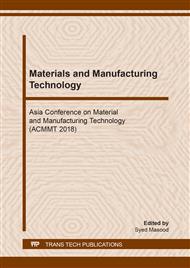[1]
O. Richmond and M.L. Devenpeck, in: Proc. 4th U.S. Nat. Congr. Appl. Mech., edited by R.M. Rosenberg, volume 2, ASME, New York, p.1053 (1962).
Google Scholar
[2]
O. Richmond and H.L. Morrison: J. Mech. Phys. Solids Vol. 15 (1967), p.195.
Google Scholar
[3]
O. Richmond, in: Theory of streamlined dies for drawing and extrusión, edited by F.P.J. Rimrott, J. Schwaighofer, Mechanics of the Solid State, University of Toronto Press, Toronto p.154 (1968).
DOI: 10.3138/9781487575199-014
Google Scholar
[4]
K. Chung and O. Richmond: Int. J. Mech. Sci. Vol. 34 (1992), p.617.
Google Scholar
[5]
K. Chung and O. Richmond: Trans. ASME J. Appl. Mech. Vol. 61 (1994), p.176.
Google Scholar
[6]
K. Chung and S. Alexandrov: Appl. Mech. Rev. Vol. 60 (2007), p.316.
Google Scholar
[7]
A.G. Atkins: J. Mater. Process. Technol. Vol. 56 (1996), p.609.
Google Scholar
[8]
M.A. Shabara, A.A. El-Domiaty and M.A. Kandil: J. Mater. Eng. Perform. Vol. 5 (1996), p.478.
Google Scholar
[9]
R. Hambli and M. Reszka: Int. J. Mech. Sci. Vol. 44 (2002), p.1349.
Google Scholar
[10]
M.D. Cockroft and D.J. Latham: J. Inst. Metals Vol. 96 (1968), p.33.
Google Scholar
[11]
S.I. Oh, C.C. Chen and S. Kobayashi: Trans. ASME J. Eng. Ind. Vol. 101 (1979), p.36.
Google Scholar
[12]
S.E. Clift, P. Hartley, C.E.N. Sturgess and G.W. Int. J. Mech. Sci. Vol. 32 (1990), p.1.
Google Scholar
[13]
D.-C. Ko, B.-M. Kim and J.-C. Choi: J. Mater. Process. Technol. Vol. 62 (1996), p.166.
Google Scholar
[14]
M. Jain, J. Allin and D.J. Lloyd: Int. J. Mech. Sci. Vol. 41 (1999), p.1273.
Google Scholar
[15]
A.T.J. Domanti, D.J. Horrobin and J. Bridgwater: Int. J. Mech. Sci. Vol. 44 (2002), p.1381.
Google Scholar
[16]
J. Landre, A. Pertence, P.R. Cetlin, J.M.C. Rodrigues. and P.A.F. Martins: Finite Elem. Anal. Des. Vol. 39 (2003), p.175.
Google Scholar
[17]
K. Komori: Int. J. Mech. Sci. Vol. 45 (2003), p.141.
Google Scholar
[18]
X. Duan, X. Velay and T. Sheppard: Mater. Sci. Eng. Vol. 369A (2004), p.66.
Google Scholar
[19]
R.B. Figueiredo, P.R. Cetlin and T.G. Langdon: Mater. Sci. Eng.Vol. 518A (2009), p.124.
Google Scholar
[20]
B. Avitzur: Trans. ASME J. Eng. Ind. Vol. 90 (1968), p.79.
Google Scholar
[21]
B. Avitzur and J.C. Choi: Trans. ASME J. Eng. Ind. Vol. 108 (1986), p.317.
Google Scholar
[22]
R.T. Shield: J. Mech. Phys. Solids Vol. 3 (1955), p.246.
Google Scholar
[23]
S.N. Samy, C.A.R. Saleh and A.R. Ragab: Proc. IMechE Part C: J. Mech. Eng. Sci. Vol. 220 (2006), p.1201.
Google Scholar
[24]
K. Komori: Int. J. Mech. Sci. Vol. 41 (1999), p.1499.
Google Scholar
[25]
O. Richmond and S. Alexandrov: Compt. rendus de l'Académie des Sci. Ser. II b. 328 (2000), p.835.
Google Scholar
[26]
R. Hill: The Mathematical Theory of Plasticity (Clarendon Press, Oxford 1950).
Google Scholar
[27]
H.F. Weinberger: Meccanica Vol. 38 (2003), p.547.
Google Scholar


